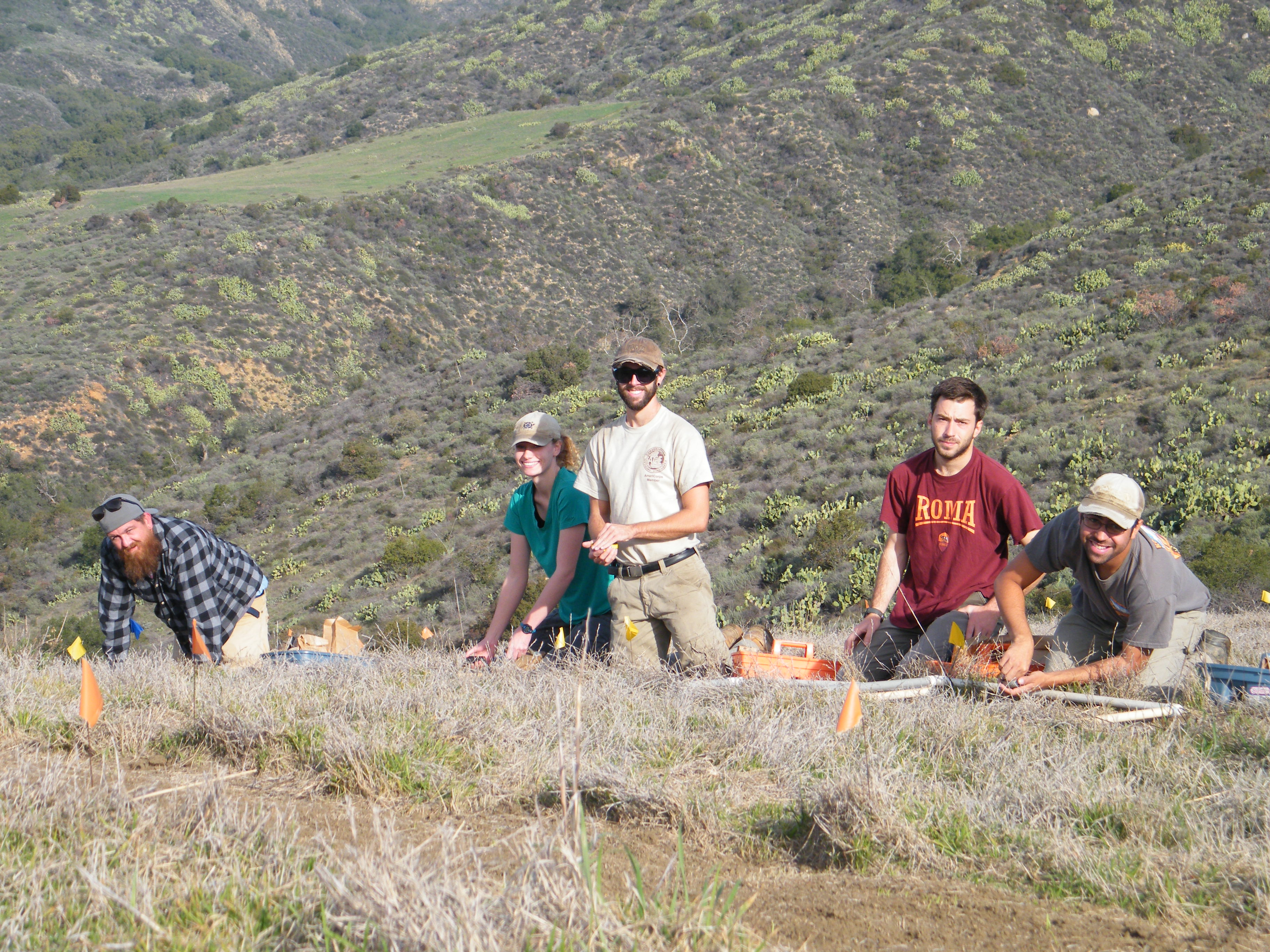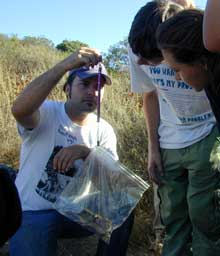 About Starr Ranch
About Starr Ranch
Starr Ranch is a 4000 acre Audubon preserve in southeast Orange County, California. Our activities at the Ranch focus on four major areas: land management, monitoring and applied habitat and wildlife research, education, and conservation advocacy. We take an adaptive management approach, using experiments to test most of the techniques we employ to remove weeds without herbicides and restore native habitat. Artichoke thistle has invaded approximately 700 acres of degraded and native grasslands. It was first on our list of invasive plant species prioritized for immediate research and control.
- Land Management Brief
- 2009 U.S. Fish and Wildlife Certificate of Appreciation
- 2010 Land Manager of the Year
- 2016 Conservation Award
About Artichoke Thistle
(Cynara cardunculus)
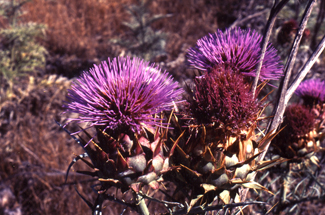 Artichoke thistle is a robust, spiny member of the Composite Family. It is on the California Department of Food and Agriculture “B” list of noxious weeds, which contains some of California’s most invasive and wide-spread wildland pest plants. Artichoke thistle originated in the Mediterranean Basin but has invaded grasslands in South America, Australia, and California. Two cultivated forms, globe artichoke and cardoon, were brought to California from southern Europe in the 19th century and escaped and spread. Artichoke thistle is a perennial with a taproot that can grow down to six feet. Our research at Starr Ranch has shown that flower heads have an average of 180 – 800 seeds and each plant may have 3 heads but in some years as many as 12.
Artichoke thistle is a robust, spiny member of the Composite Family. It is on the California Department of Food and Agriculture “B” list of noxious weeds, which contains some of California’s most invasive and wide-spread wildland pest plants. Artichoke thistle originated in the Mediterranean Basin but has invaded grasslands in South America, Australia, and California. Two cultivated forms, globe artichoke and cardoon, were brought to California from southern Europe in the 19th century and escaped and spread. Artichoke thistle is a perennial with a taproot that can grow down to six feet. Our research at Starr Ranch has shown that flower heads have an average of 180 – 800 seeds and each plant may have 3 heads but in some years as many as 12.
Biology and Ecology of Artichoke Thistle
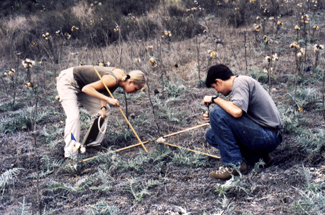 In 1997, we began investigations on biology and ecology of artichoke thistle. We asked many questions: how many seeds are plants capable of producing per year, how far can seeds disperse, what conditions do seedlings require to survive? We have learned many things about this formidable weed. Seed production is strongly influenced by rainfall and is much higher in years of higher precipitation. Despite their long, bristly dandelion-like appendage, most seeds do not travel much farther than 6 feet from the parent plant. Seeds germinate and establish under a wide range of conditions: on gopher mounds, under annual and perennial grasses, under mature artichoke thistle, and in artichoke thistle litter.
In 1997, we began investigations on biology and ecology of artichoke thistle. We asked many questions: how many seeds are plants capable of producing per year, how far can seeds disperse, what conditions do seedlings require to survive? We have learned many things about this formidable weed. Seed production is strongly influenced by rainfall and is much higher in years of higher precipitation. Despite their long, bristly dandelion-like appendage, most seeds do not travel much farther than 6 feet from the parent plant. Seeds germinate and establish under a wide range of conditions: on gopher mounds, under annual and perennial grasses, under mature artichoke thistle, and in artichoke thistle litter.
Small animals such as rodents and birds eat artichoke thistle seeds, but no animals ate seedlings in our experiments. A study in 48 of our grassland stands determined some factors associated with high artichoke thistle cover and density. We found that there is an association with gopher mounds. We know that gophers don’t eat seedlings from our experiments, but we have watched pocket gophers eat the stalks of mature plants (spines and all!). We also discovered the first Orange County record of Terellia fusicornis, a fly that lays its eggs in artichoke thistle flower heads. The eggs hatch and the larvae eat the ripening seeds. In our five year study of effects of coastal sage scrub restoration on songbirds and small mammals, we found that artichoke thistle-dominated sites provide poor songbird and small mammal habitat relative to native habitat (grassland and coastal sage scrub).
Artichoke Thistle Control
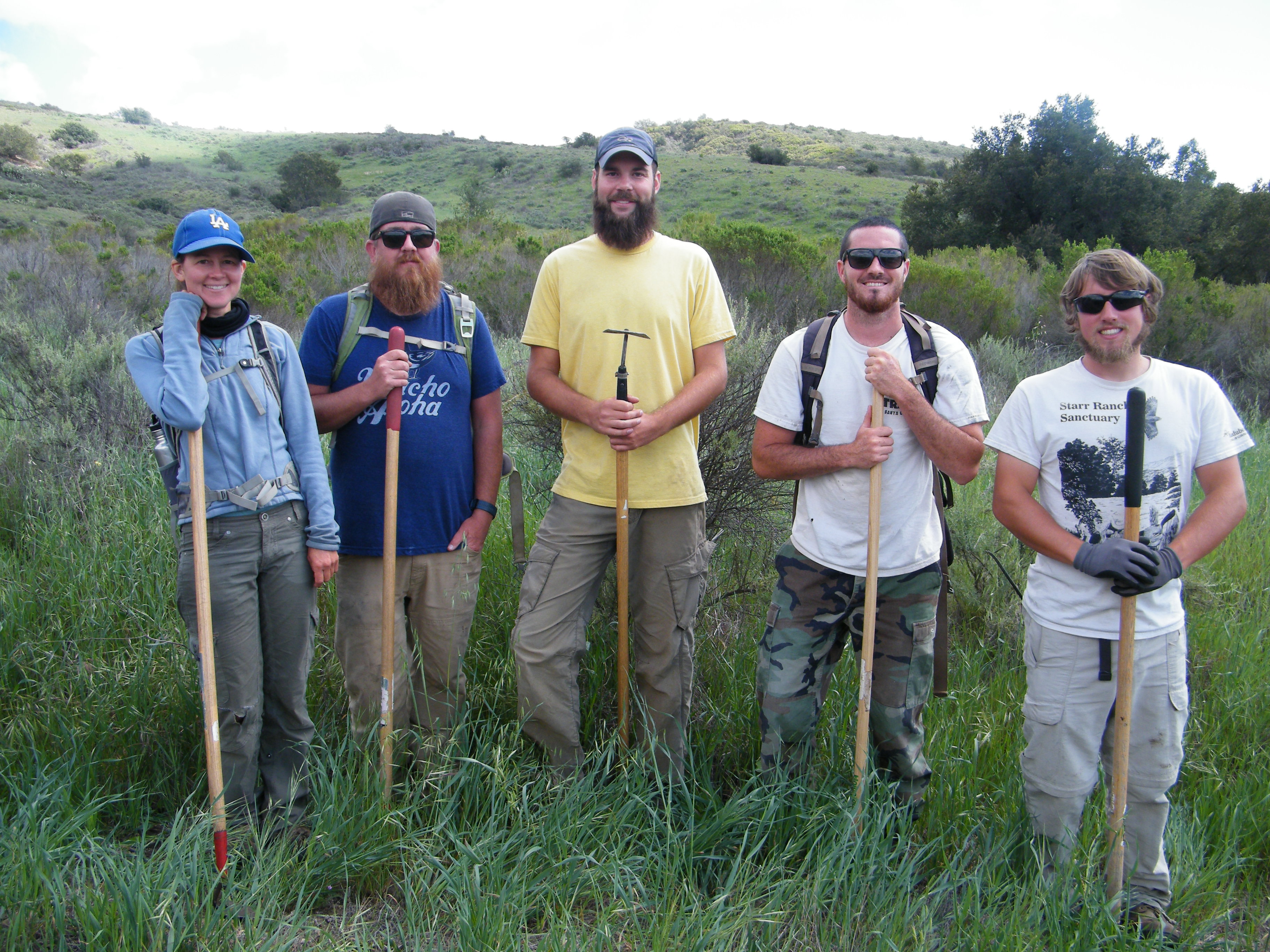
We were convinced. In 1999, we began removal treatments in twelve native bunchgrass stands (240 acres), invaded to varying degrees by artichoke thistle. Crews of 2 – 4 went out with brush cutters every three weeks from December – March then every four weeks until plants died back during the summer drought. We began surface tilling in smaller (< 1 acre) more heavily invaded areas using a new tractor with MeriCrusher attachment in winter, 2000. By 2014, we had reduced artichoke thistle to < 5% cover after one season per stand in 520 acres of native and degraded grassland habitat. However, we continue to monitor and treat seedlings that germinate from seed banks. After one year of repeated brush cutter or surface till treatments, our crews switch to hoes and cutting intervals become four, six, or eight week depending on monitoring data.
Coastal Sage Scrub & Native Grassland Restoration
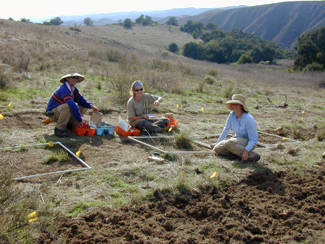 Removal of artichoke thistle results in large patches of bare ground that are prime invasion sites for other non-native species, both grasses and forbs. We have tested timing and effectiveness of non-chemical approaches to control of weeds other than artichoke thistle that include use of a propane flamer during the rainiest part of the year, machetes, brush cutting, surface tilling, and hand weeding.
Removal of artichoke thistle results in large patches of bare ground that are prime invasion sites for other non-native species, both grasses and forbs. We have tested timing and effectiveness of non-chemical approaches to control of weeds other than artichoke thistle that include use of a propane flamer during the rainiest part of the year, machetes, brush cutting, surface tilling, and hand weeding.
In year two of artichoke thistle treatment, we begin restoration to native habitat. In some sites, shrub species of the endangered shrubland, coastal sage scrub, have already begun to colonize. In these sites, work involves enhancement of the scrub stand that had already begun to form. Field crews hand broadcast native seed collected on Starr Ranch into 3 – 6 ft wide strips with 3 – 30 ft wide unplanted buffers in between, an efficient and effective approach pioneered at Starr Ranch. We also monitor passive restoration or natural colonization from shrubland edges into adjacent grasslands. Ongoing experiments on planting techniques guide decisions on seed rates and timing of direct seeding. By the end of the 2013-14 season, our coastal sage restoration work, active and passive, included 240 acres. Standards for coastal sage scrub restoration (i.e. which shrub species to plant and at what densities) come from intensive sampling in 54 stands of beautiful mature coastal sage scrub at Starr Ranch. In spring, 2004 we commenced a long term study that examined effects of scrub restoration on songbirds and small mammals which indicated trends of increasing songbird and small mammals species richness from baseline through 12 year old restoration sites. In 2013-14, we began tests of new species for planting in “climate-smart” restoration sites that have characteristics adapted to the projected future climate of southern California (extended periods of drought punctuated by infrequent periods of intense rainfall.
In minimally invaded native grassland sites where the native bunchgrass, purple needlegrass (Stipa pulchra), is dominant, we tested planting of seeds and plugs of the bunchgrass. We are also testing if different timings and intensities of mowing treatments enhance our declining needlegrass grassland stands. Starr Ranch protects some of the last native needlegrass grasslands in California. We are currently sampling in six of our best native grassland stands long term to establish standards for bunchgrass density and cover as well as forb species expected in a prime native grassland. Since 2007, during the breeding season, our seasonal field crew has done qualitative surveys for two songbird indicators of grassland habitat quality, Western Meadowlark and Grasshopper Sparrow. Thus far, both species have shown no trends (i.e. populations appear stable, no increase or decrease).
The Future
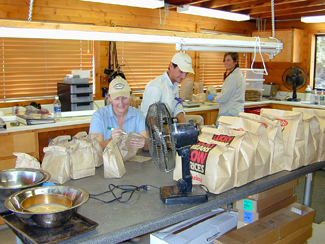 We add 10 – 20 new acres of thistle-invaded sites for treatment each year. At this rate, our goal is to have artichoke thistle under control at Starr Ranch by 2020. We begin work on control of other upland non-natives as we initiate restoration, year two of artichoke thistle control.
We add 10 – 20 new acres of thistle-invaded sites for treatment each year. At this rate, our goal is to have artichoke thistle under control at Starr Ranch by 2020. We begin work on control of other upland non-natives as we initiate restoration, year two of artichoke thistle control.
Currently, all invasive control treatments, restoration, and research is done by a field crew leader and four field assistants who live at the Ranch for 6-10 months. Field crews closely track their work hours. Estimated costs for artichoke thistle and other exotic control as well as restoration is approximately $400/acre, based on a $20/hour/person rate.
Thanks to the following:
- Manager, Pete DeSimone
- Field Crew Leaders: Matt Lechmaier, Jenny McCabe, John Dvorak, Justin Valliere, Matt Skarie
- Our hard working Field Assistants, (50 since 2001-02)
- Seed collectors and processors: Debbie Gley, Stacee Lockard, Helen de la Maza
- Restoration ecologist, Dr. Margot Griswold of Earthwork Construction and Design
- Volunteers who have generously helped with hoeing thistle resprouts and collecting, counting, and processing many seeds
- U.S. Fish & Wildlife Service for “Partners for Fish and Wildlife” and “Private Land Stewardship” funding
- Natural Resources Conservation Service for WHIP, EQIP, and other funding
- Wells Fargo, the S.L. Gimbel Foundation, Orange County Community Foundation, and Union Bank Foundation for funding
Sandy DeSimone, Ph.D
Director, Research and Education
Starr Ranch Sanctuary
September, 2015
